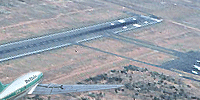 |
 |
|
||||
|
By
Wikipedia,
The Martinsyde G.100 "Elephant" and the G.102 were British fighter bomber aircraft of the First World War built by Martinsyde . It gained the name "Elephant" from its relatively large size and lack of manoeuvrability. The G.102 differed from the G.100 only in having a more powerful engine. Operational UseThe G100 was built originally as a long range, single-seat fighter and escort machine but on the basis of its size and weight was reclassified as a day bomber. It successfully performed this role from the summer of 1916 through to the closing weeks of 1917. It was also used for long-range photo reconnaissance, where stability and endurance were required (the type was capable of a five and a half hour flight) . Variants
Operators
Specifications (G.100)Data from The British Fighter since 1912 General characteristics
Performance
Armament
See alsoRelated lists External links
Text from Wikipedia is available under the Creative Commons Attribution/Share-Alike License; additional terms may apply.
Published in July 2009. Click here to read more articles related to aviation and space!
|
||||||||||||||||||||||||||||||||||||||||||||||

 |
|
Copyright 2004-2025 © by Airports-Worldwide.com, Vyshenskoho st. 36, Lviv 79010, Ukraine Legal Disclaimer |